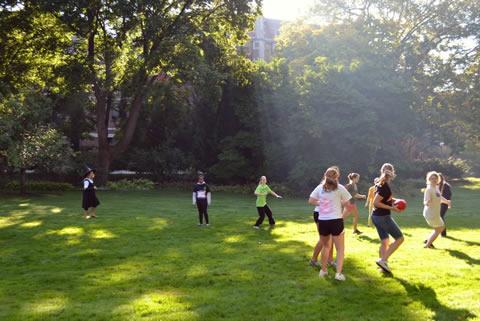Catherine Walsh Davis ’70, ’76 and Kathy Graneggen Moberg ‘79
Those of us who lived at Martha Cook often think of the Building in terms of traditions and sometimes wince at the thought that the Building or, more precisely, the life style at MCB might differ from the halcyon days we remember. But, as we have discovered, change itself is a Martha Cook tradition. Consistently through the years, adaptations have been made in almost every aspect of life at Martha Cook to better meet the needs of its residents, update the infrastructure, or to reflect societal or technological changes. Even supposedly set-in-stone institutions, such as Friday teas or Dinner for New Women, have morphed over the years. Some old customs have disappeared and new practices have become traditions.
Consider the following three examples of changing Cookie traditions—one which altered slightly during its lifetime but no longer exists, one that took on new form, and one very new tradition.
Cookies who lived at MCB prior to 1973 remember—some fondly, others with horror, (whichever emotion we feel is probably directly related to how well we scored)—the “Name Game.” During the first few weeks of sit-down dinners, we were assigned a different seat in the dining room each evening so that we met virtually each of our fellow Cookies. Then, we were tested: could we name our fellow residents? In most years, those having the 10 lowest scores were required to perform a skit at a later all-house party. The “test” began in 1915 as a game played in the Blue Room (now Gold Room) when each and every girl stood in turn to be recognized. In 1940, the game changed to a dinner-time activity. It was held as the opening to an all-house meeting in 1958. By fall 1968, it returned to a dinner time event with only 10 randomly chosen women standing to be named. The name challenge continued until it simply disappeared from Cookie life in 1973 with no mention in House Board Minutes, Social Director’s Report, or Governors Minutes.

Drawing by Rosemary Lawrence '24 from the 1923 Martha Cook Annual
The Holiday Breakfast, with its candle-lit caroling procession through the dark halls in the early hours of a December morning, began in 1915 and by 1926 was a mother-daughter overnight affair. Residents invited their mothers to dinner on the evening before the last day of classes before the Christmas break (remember, semesters did not end until mid-January in the “old days”). The Building was closed at 10:30 and a pajama party was held in the Blue Room. Following the performance of a play starring some of the residents, the women of the Building presented their mothers with gaily wrapped toys to be opened and admired, then packed into a large box to be sent the next day to the pediatric unit of the hospital. A bugler played Reveille to wake the residents and their mothers at 5:30 am, and then, beginning at 6 am on the 4th floor, fully-dressed moms and daughters proceeded downward through the Building, singing carols and lighting the candles of women waiting in their room doorways. Beginning in 1935, when the hospital was more in need of money than toys, the women stopped donating “dime-store gifts” and instead each girl contributed 10 cents. During World War II gas, food, and staff shortages caused a cessation of the special party. The breakfast resumed in 1945 but mothers were no longer invited and the evening activities ceased; morning carols and breakfast continued. Further modifications included the permission to wear pajamas at breakfast (the only day of the year) and the shifting of the day of the brunch from the last day of classes to the first day of study days in 1975.
March 2009 saw the inaugural Harry Potter Week at MCB, a new tradition combining floor bonding and raising money for charity with the popular book series the current generation grew up reading. For a week, the Martha Cook Building becomes Hogwarts Castle, the novels’ magical boarding school, with each of the floors taking on the identity of one of the school’s four houses (the mezzanines join with the first floor). Chef Gary creates a special Harry Potter Buffet, and there is a movie night in the Gold Room with themed snacks and Harry Potter films. Residents decorate, wear house colors, devise floor passwords and compete in the Penny Wars. Each “house” has a jar. Pennies are positive points, while paper and silver money (donated by rival houses), result in negative points! The floor with the most positive or least negative points, at the end of the week, wins the House Cup and the money goes to a charity such as Ronald McDonald House or Relay for Life. Everything culminates in a rousing game of Quidditch in the garden on Saturday. The rules to this game change from year to year, but nerf balls, hula hoop goals and Cookie charm are staples, and the prize is a stash of pennies!

